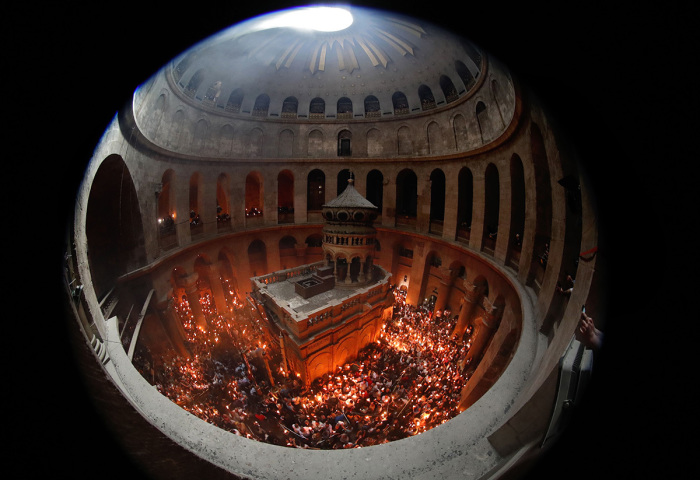Excavations under Church of the Holy Sepulchre reveal evidence of ancient garden, supporting Gospel of John

Archaeologists excavating beneath the Church of the Holy Sepulchre in Jerusalem’s Old City have uncovered evidence of an ancient garden.
The findings, revealed through a landmark excavation conducted as part of renovations in the church, showed evidence of the presence of olive trees and grapevines from around 2,000 years ago. This evidence aligns with the Gospel of John’s description of the site where Jesus was crucified and buried.
“Now in the place where he was crucified there was a garden, and in the garden a new tomb in which no one had yet been laid.” (John 19:41)
Traces of the olive trees and grapevines were identified via archaeobotanical and pollen analysis.
The excavation, led by Professor Francesca Romana Stasolla of Sapienza University in Rome, began in 2022 as part of a restoration project. It marks the first major renovation in the church since the 19th century and had to be agreed upon by the church’s three main custodians: the Greek Orthodox Patriarchate, the Custody of the Holy Land (Roman Catholic) and the Armenian Patriarchate. It also required a license from the Israel Antiquities Authority.
“With the renovation works, the religious communities decided to also allow archaeological excavations under the floor,” Stasolla told the Times of Israel. At present, there are no exposed digging areas, as the churches are preparing for the upcoming Easter celebrations, which usually bring large crowds of pilgrims.
During the excavations, the team dug beneath the basilica’s floor, uncovering layers dating back to the Iron Age, including pottery, oil lamps and burial sites. The pre-Christian era garden evidence, found in soil samples, suggests the area transitioned from a quarry to cultivated land before becoming a burial site.
The Church of the Holy Sepulchre marks the traditional site of both Golgotha (Calvary) and Jesus’ tomb. The first church on the site was established by Emperor Constantine in the 4th century after his mother, Helena, identified the location.
The excavation by Stasolla’s team also revealed a circular marble base beneath the aedicule — the shrine encasing the tomb — believed to be part of Constantine’s original structure, as early depictions from the fifth and sixth centuries describe it as circular. Further tests are underway to determine the marble’s origin and provide additional historical insights.
The site has seen a dramatic change over time. Originally a quarry outside the walls of Jerusalem during the time of Jesus, the site later became a cemetery with rock-cut tombs — a common burial practice in ancient Israel.
It was initially located outside the city walls during the 1st century; however, in the 2nd century A.D., it was incorporated into the city as part of Aelia Capitolina, with a temple to Venus built over it by the Emperor Hadrian.
Constantine’s church completely replaced this temple and was built to enclose both the crucifixion and burial sites.
While Constantine built the first church there, the site has been rebuilt multiple times. The Persians burned the church in the 600s A.D., while it was attacked and severely damaged under the sixth Fatimid caliph, Al-Hakim, in the 11th century. During the Crusader period, the church was renovated and given the layout and style it has today.
The excavation uncovered low stone walls and filled-in soil, suggesting efforts to turn the former quarry into a cultivated area, which aligns with the Gospel’s mention of a garden.
“Low stone walls were erected, and the space between them was filled with dirt,” said Stasolla. “The archaeobotanical findings have been especially interesting for us, in light of what is mentioned in the Gospel of John, whose information is considered written or collected by someone familiar with Jerusalem at the time. The Gospel mentions a green area between the Calvary and the tomb, and we identified these cultivated fields.”
While radiocarbon dating of the garden traces is pending, the archaeological context ties them to the period before Christianity’s rise, offering a glimpse into the landscape Jesus might have known.
The archaeological team, operating under the oversight of La Sapienza University, could not excavate the entire area under the flooring at one time. Instead, Stasolla and her team divided the area into zones, uncovering and excavating each one at time, before covering it over.
However, they are now planning to make a multimedia reconstruction of all the areas.
“While we have not been able to see the entire church excavated in one glance, new technologies are allowing us to reconstruct the bigger picture in our labs,” Stasolla said. “If we were talking about a puzzle, we could say we are only excavating one piece at a time, but eventually, we will have a complete multimedia reconstruction of the full picture.”
The final round of excavations is set to resume after Easter, however, the documentation and publication of the findings will likely take many years.
Stasolla declined to answer the question of whether Jesus was actually buried at the site, saying, “It is the faith of those who have believed in the holiness of this site for millennia that has allowed it to exist and transform.”
“Whether someone believes or not in the historicity of the Holy Sepulchre, the fact that generations of people did is objective,” she noted, saying the history of the Holy Sepulchre is “the history of Jerusalem.”
This article was originally published by All Israel News.
ALL ISRAEL NEWS is based in Jerusalem and is a trusted source of news, analysis and information from Israel to our Christian friends around the world.





























